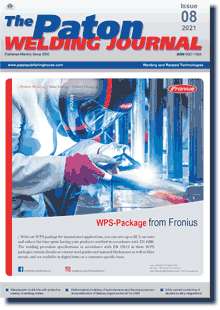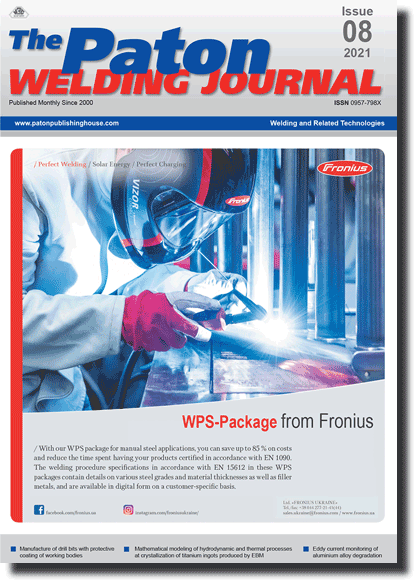| 2021 №08 (07) |
DOI of Article 10.37434/tpwj2021.08.08 |
2021 №08 (09) |

The Paton Welding Journal, 2021, #8, 38-44 pages
Mathematical modeling of hydrodynamic and thermal processes at crystallization of titanium ingots produced by EBM
S.V. Akhonin1, V.O. Berezos1, O.I. Bondar2, O.I. Glukhenkyi2, Yu.M. Goryslavets2 and A.Yu. Severin1
1E.O. Paton Electric Welding Institute of the NASU. 11 Kazymyr Malevych Str., 03150, Kyiv, Ukraine. E-mail: office@paton.kiev.ua
2Institute of Electrodynamics of the NAS of Ukraine 56 Peremohy Prosp., 03057, Kyiv, Ukraine. E-mail: bondar_o_i@ukr.net
Abstract
It is shown that when specifying the efficiency of EBM process, the phenomenon of thermogravitational convection is a weighty factor, which determines the thermal state of the ingot. A mathematical model of interrelated hydrodynamic and thermal processes in the crystallizing metal, taking into account the phenomena of thermogravitational convection, was formulated for a steady-state mode of the process of electron beam melting of titanium into a straight-through cylindrical mould. The thermal state of the ingot as well as the position of the crystallization front at a continuous feeding of liquid titanium from the cold hearth into the mould depending on metal temperature at the inlet and speed of ingot drawing for a laminar mode of hydrodynamic flow in the liquid pool was determined. It is found that at increase of metal temperature at the inlet into the mould in the studied range (2040‒2100 K) shifting of the point of maximum pool depth from the ingot axis becomes smaller. Calculations within the constructed mathematical model were used to study the impact of the rate of liquid metal feed from the cold hearth into the mould on the shape and depth of a liquid pool. It is found that at increase of ingot drawing rate by 30 % the liquid pool depth increases by 1.5 times, and the point of the maximum liquid pool depth becomes close to the ingot axis. 10 Ref., 1 Table, 9 Figures.
Keywords: mathematical modeling; electron beam melting; hydrodynamic and thermal processes; ingot; titanium; continuous casting
Received 03.02.2021
References
1. Bellot, J.-P., Flori, E., Ess, E., Ablizer, D. (1996) Mathematical modeling of electron beam melting process with cold hearth and its application for titanium manufacture. Problemy Spets. Elektrometallurgii, 4, 27–37 [in Russian].2. Paton, B.E., Trigub, N.P., Kozlitin, D.A. et al. (1997) Electron beam melting. Kiev, Naukova Dumka [in Russian].
3. Paton, B.E., Trigub, N.P., Akhonin, S.V., Zhuk, G.V. (2006) Electron beam melting of titanium. Kiev, Naukova Dumka [in Russian].
4. Lesnoj, A.B., Demchenko, V.F., Zhadkevich, M.L. (2001) Modeling of hydrodynamics and heat exchange in crystallization of ingots of electron beam remelting. Problemy Spets. Elektrometallurgii, 2, 17–21 [in Russian].
5. Zhuk, G.V., Kalinyuk, A.N., Trigub, N.P. (2002) Modeling of conditions of removal of shrinkage pipe from cylindrical ingots. Advances in Electrometallurgy, 1, 19–21.
6. Zhuk, G.V., Akhonina, L.V., Trigub, N.P. (1998) Mathematical modeling of crystallization processes of Ti–6Al–4V titanium alloy in EBCH. Problemy Spets. Elektrometallurgii, 2, 21–25 [in Russian].
7. Akhonin, S.V., Gorislavets, Yu.M., Glukhenkiy, A.I. et al. (2019) Modeling hydrodynamic and thermal processes in the mould in cold-hearth electron beam melting. Suchasna Elektrometall., 4, 9-17 [in Russian]. https://doi.org/10.15407/sem2019.04.02
8. Mills, K. (2002) Recommended values of thermophysical properties for selected commercial alloys. Woodhead publishing limited. https://doi.org/10.1533/9781845690144
10. Zhuk, G.V. (2008) On influence of metal heating power distribution in mould in EBCHM process on structure of titanium ingots. Advances in Electrometallurgy, 2, 15–18.
Suggested Citation
S.V. Akhonin, V.O. Berezos, O.I. Bondar, O.I. Glukhenkyi, Yu.M. Goryslavets and A.Yu. Severin (2021) Mathematical modeling of hydrodynamic and thermal processes at crystallization of titanium ingots produced by EBM. The Paton Welding J., 08, 38-44.The cost of subscription/purchase order journals or individual articles
| Journal/Currency | Annual Set | 1 issue printed |
1 issue |
one article |
| TPWJ/USD | 384 $ | 32 $ | 26 $ | 13 $ |
| TPWJ/EUR | 348 € | 29 € | 24 € | 12 € |
| TPWJ/UAH | 7200 UAH | 600 UAH | 600 UAH | 280 UAH |
| AS/UAH | 1800 UAH | 300 UAH | 300 UAH | 150 UAH |
| AS/USD | 192 $ | 32 $ | 26 $ | 13 $ |
| AS/EUR | 180 € | 30 € | 25 € | 12 € |
| SEM/UAH | 1200 UAH | 300 UAH | 300 UAH | 150 UAH |
| SEM/USD | 128 $ | 32 $ | 26 $ | 13 $ |
| SEM/EUR | 120 € | 30 € | 25 € | 12 € |
| TDNK/UAH | 1200 UAH | 300 UAH | 300 UAH | 150 UAH |
| TDNK/USD | 128 $ | 32 $ | 26 $ | 13 $ |
| TDNK/EUR | 120 € | 30 € | 25 € | 15 € |
AS = «Automatic Welding» - 6 issues per year;
TPWJ = «PATON WELDING JOURNAL» - 12 issues per year;
SEM = «Electrometallurgy Today» - 4 issues per year;
TDNK = «Technical Diagnostics and Non-Destructive Testing» - 4 issues per year.


